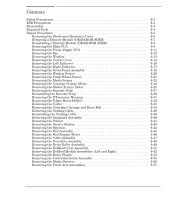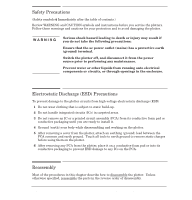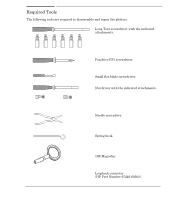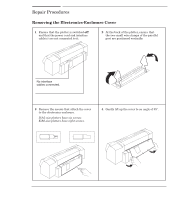HP Designjet 700 Service Manual - Page 52
FrontĆPanel PCA, Drop Sensor PCA, PowerĆSupply PCA, Fan power, MIO, RSĆ232driver, Carriage PCA
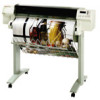 |
View all HP Designjet 700 manuals
Add to My Manuals
Save this manual to your list of manuals |
Page 52 highlights
FrontĆPanel PCA The front panel consists of: D A 2Ćrow by 20Ćcharacter vacuumĆfluorescent display (VFD). D Seven LED indicators (six LEDs on the HP DesignJet 700). D A 10Ćbutton key pad. The servo processor on the main PCA writes serially to the VFD and the LEDs and reads the key pad on its input/output lines. It provides local control, configuration and testing of the plotter and displays various plotter conditions. Drop Sensor PCA The drop sensor is located in the dropĆdetect assembly. Its purpose is to detect ink drops during cartridge testing. The drop sensor contains a detector system that detects the presence of a drop shortly after it is fired into the detector. In order for the drop to be fired into the detector, the cartridge must be positioned over the sensor. An infrared LED sends a beam across an aperture which is received at the other side by a photoĆsensitive diode. When a drop passes through the beam, it causes a disturbance in the reception. The slight modulation in power output by the receiving diode is amplified by the preĆamplifier, further amplified by the amplifier, and sent to the processorĆsupport ASIC on the main PCA. The processorĆsupport ASIC can measure the time between the firing of a printĆhead nozzle and reception of the amplified dropĆdetect signal in less than 900 microseconds. PowerĆSupply PCA An autoĆranging power supply is located in the electronics enclosure assembly. It accepts and automatically adjusts to an ac input of 90 V through 264 V and produces regulated voltages of +5 V, +12 V, and -12 V and an unregulated +24 V. These voltages, produced by the power supply, are used as follows: D +24 V D +12 V D -12 V D +5 V Motor drivers and cartridge voltage regulator on the main PCA. (Regulated +9 to +15 V for cartridge circuits on the carriage PCA). Fan power, MIO, RSĆ232 driver, Carriage PCA, Drop Sense PCA. Also used for programming Flash SIMMs on the Main Board. RSĆ232 driver. IC power and sensors, and FrontĆPanel PCA. The primary portion of the supply contains fusing and input protection circuitry, line filters, and a rectifier. The primary output is converted to a pulseĆwidthĆmodulation (PWM), unidirectional current by a flyback dcĆtoĆdc converter. The secondary portion of the power supply contains the four secondary windings of the transformer that convert the PWM current in the primary to four ac voltages, which are rectified to the +5 V, +12 V, -12 V and +24 V dc voltages required by the plotter. Standard +12 V and -12 V regulators are included in the secondary portion of the power supply. 5-10 Functional Overview C4705-90000










